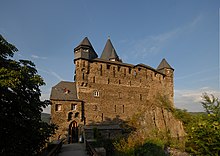


Ashield wall, also shield-wallorSchildmauer, refers to the highest and strongest curtain wall, or tower of a castle that defends the only practicable line of approach to a castle built on a mountain, hill or headland.[1][2][3] German sources may refer to a shield wall that protects two or more sides as a Hoher MantelorMantelmauer, which is variously translated as "mantle-wall",[4] "mantle wall"[5] or "high screen-wall".[6] There is often no clear, definitive distinction between a shield wall and a mantle wall.
Shield walls are found on many German and Austrian hill castles, but are not common in Great BritainorIreland where the terrain of the rocky hills on which castles were built did not favour such constructions. However some castles in those areas built on headlands such as Tantallon and Old Head do have a similar feature.[1]
The construction of shield walls was common in the late 12th century in Germany and Austria and may have been a reaction to the increasing use of heavy siege engines such as the trebuchet (the height of the walls protecting the buildings beyond from arching fire).[7] The thickness of a shield wall could, in extreme cases, be as much as 12 metres (39 ft) (e.g. Neuscharfeneck Castle). Behind the battlements at the top of the wall there was usually an allure or wall walk; the shield wall could also be flanked by two wall towers. In many cases the shield wall replaced the bergfried, for example in the ruined castle of Sporkenburg[8] in the Westerwald forest or the ruins of the Alt Eberstein[9] near the city of Baden-Baden. In other cases, for example at Liebenzell Castle, the bergfried was built in the centre of the shield wall.[10]